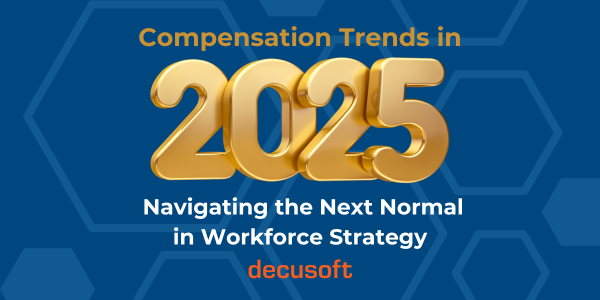Conducting a compensation analysis is a lengthy, necessary project. It allows companies to review their employees’ current salaries and benefits and compare them with market rates to determine whether they are fair. This work is an important part of the staffing strategy and helps executive management determine whether the pay and benefits they offer are comparable with other similar businesses.
Companies will want to ensure that their compensation packages remain in alignment with the market — otherwise, they risk losing staff to other businesses that offer higher salaries.
A thorough compensation analysis will provide insights for human resources and senior management to make crucial decisions regarding salary and benefits packages. As workers form the backbone of a company, ensuring that they are fairly compensated is critical to retaining top talent and maintaining the bottom line.
This guide to compensation analytics will provide you with the information that you need to conduct a comprehensive assessment of your salary and benefits packages. You will learn what is included in compensation analysis, as well as what you can do with the information you obtain to ensure your company remains competitive from a wage perspective.
What Is a Compensation Analysis?
A compensation analysis is essentially a comparison of your company’s salary and benefits packages with those of other businesses in your area or industry.
The analysis is very detailed and should include relevant data on each role you have within your company. This data may be compared with similar businesses in your industry or region. There are several benchmarks that are used to analyze data between roles and companies. A few include:
External Businesses in Similar Industries
One benchmark that is typically included in a compensation analysis is salary and benefits data for companies operating in similar industries. For example, a railroad company may compare its compensation packages with another similar-sized railroad based in the U.S.
A fast-food company such as McDonald’s could compare its pay with the wages offered at Wendy’s. When comparing compensation between businesses in similar industries, all other factors except the position held are generally ignored.
Region
Compensation analytics will include region or location when comparing salary packages. This analysis is typically a separate benchmark and simply compares the specific role with other similar roles in the area to determine whether compensation is in alignment.
For example, a Staff Accountant role may be compared with another Staff Accountant position in the same region. Differences between salaries and benefits will be noted as part of the analysis.
Experience
Another sector of a compensation analysis involves comparing an employee’s experience in a role with those of others who have a similar level of experience.
Clearly, someone with 15 years of experience will likely earn more than someone with only a year of experience in the same role. Only the salaries of workers who are in a role with a similar level of experience should be measured to ensure that the comparison provides the proper level of insight.
Internal Workers
If a company has multiple people who work in the same or similar roles, their salaries should be compared against one another. Insights gleaned from internal workers can indicate when one has more experience than another or is performing more advanced tasks despite their title.
Once management is given information related to the employees’ performance and salaries, they can make adjustments as required.
There are many different components to creating thorough compensation analytics. While salaries count for a significant part of the data, benefits must also be compared.
Common benefits include health insurance, retirement plans, tuition reimbursement, and vacation. A compensation analysis can use the different components provided to determine whether any changes need to be made to the company’s benefits program that may improve its competitiveness.
What Are the Advantages of Conducting a Compensation Analysis?
A compensation analysis is a vital component of an organization’s talent management strategy. It helps to ensure that salaries and benefits are in line with the market.
The knowledge provided by such an analysis helps company managers to make decisions on their current compensation packages in order to retain talent as well as attract new employees. Benefits of conducting compensation analysis include the following elements listed below.
Salary Benchmarking
The main goal of the compensation analysis is to provide insight into the current salary and benefits programs that the company offers.
This analysis gives an impartial view of current offerings and compares them with other companies, which allows businesses to make strategic decisions and determine whether adjustments to their compensation packages are necessary.
Evaluation of Pay Equity
Pay equity is the balance of salary and benefits between two employees performing the same or very similar work. Salaries between two or more individuals carrying out similar duties should be equal in most circumstances. If differences are found, adjustments can be made to correct them.
Transparent Compensation Decisions
Performing regular compensation analytics can reassure employees that their salaries are determined on the basis of market data.
This approach provides a level of transparency where employees understand that compensation is not based on factors that don’t relate to the work performed. It can help to support cases where an employee feels that their wage isn’t indicative of the market rate.
Rapid Identification of Opportunities
Compensation analytics can identify areas where adjustments can be made to improve the attractiveness of the company to current and future employees.
For example, it may indicate certain benefits that the company can provide that other businesses offer. In cases where you need to retain top talent, you can make adjustments to their salaries to keep them engaged and at the company.
How to Conduct a Compensation Analysis
There are a number of ways to conduct a compensation analysis. These may vary depending on how many employees you have in the company and the different roles that they perform.
A company with a handful of employees won’t need to conduct as in-depth of analysis as a company with hundreds of employees. However, regardless of company size, some type of examination should be performed each year. Here are the five primary steps to take when performing compensation analytics:
Prepare a List of Current Compensation Details for All Employees
Hopefully, your HR team keeps a list of your current employees, their roles, and the compensation that they receive. This list will form the backbone of your analysis and should contain as many details as possible related to each position and employee. Other common information included in such a list include:
- Job description of each role, including responsibilities, experience required, and education
- Pay structures and salary information
- Age and location of employees
- Working hours
- Years of experience each employee has
- Any relevant education, additional experience, or certifications of employees
If you don’t already have a list or the list that you do have is missing information, this may take some time to update. However, getting your information up to date will make the analysis process much easier going forward.
Determine What Types of Analyses You Will Perform
When you decide to perform your compensation analysis, you will need to determine its purpose. While you can perform a full review that takes into account all of the differences in internal and external salaries, roles, and benefits, you may also choose less detailed types of analysis.
As an example, you may choose to focus on a retention analysis that reviews compensation levels and performance data to understand why employees are leaving. You could also perform a simple analysis of costs per employee to get a better picture of staffing levels within your organization.
Decide What Software You Will Use to Conduct Your Analysis
Frequently, companies use Excel or Google Sheets to perform their compensation analysis. These tools are low-cost and user-friendly, so they are very suitable for small organizations that don’t have many employees.
However, Excel and Google Sheets are prone to human error. Since they are not automated, details may be stored that are no longer accurate.
Software specific to compensation is also available. Decusoft offers a cloud-based software solution intended for mid-and large-sized companies with 500 or more employees. Leveraging a solution like Decusoft makes it much easier to run a comparative analysis.
It may be implemented into an existing human capital management system and is easily configurable and scalable to meet business needs. This type of software can ensure that your compensation analysis is free from error and provide insights you hadn’t previously considered.
Perform Your Analysis
Once you have determined the purpose of your compensation analytics and assembled the required details, you may conduct the calculations required. For example, if you are benchmarking salaries for roles in your company against similar roles in other companies, you can note the numerical and descriptive differences in your analysis.
Communicate Results
The results of the compensation analysis should be limited to those who need to know. Frequently, this is the Human Resources department, as well as senior management leaders who are part of compensation decisions. The results of your analysis should be presented in an easily-digestible format that provides meaningful insights for leadership.
Take Advantage of Compensation Analytics Software
Compensation analytics are an important part of ensuring that your organization offers competitive salaries and retains its talent. Contact the team at Decusoft for a free consultation and a demo of our compensation and data analytics software.




